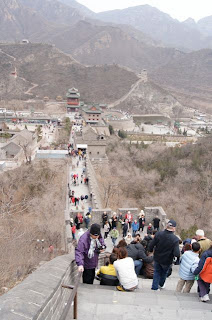It’s hard to describe the immense scale and speed of development in China at present. The cruise terminal has been constructed on reclaimed land comprising several square miles and growing daily, but that didn’t prevent their Immigration Service taking more than an hour to clear the ship, despite having had staff on board since Nagasaki – our trip thus started an hour late. Row upon row of container cranes and warehouses line the road to the mainland, which took half an hour to transit on a bus. The tree-lined dual carriageway through to Beijing runs side-by-side with the bullet train track from Tian Jin, partly tolled and partly free, taking 2 hours to cover huge tracts of farmland and development with typical Chinese apartment blocks everywhere. China is planting 1m trees annually in and around Beijing alone.
Skirting Beijing itself we travelled another 30 minutes to reach a mountainous section of the Great Wall.
The late start compressed the day such that the Wall visit was cut by nearly an hour, so there was only just time to take some shots and climb a short section of steep stairs to get a feel for the area, which is simply amazing. A few vendors and huge crowds made for a fascinating feel for this immense construction – not one continuous wall of course, but a series of sections in different places, which add up to over 4800 miles in total.
A short stop for a Chinese lunch in a People’s Canteen at the ceramic factory, complete with Saki and local beer gave us strength to tackle the Forbidden City.
A city of 18 million people, Beijing is not just the Capital of China but was also the heart of a huge empire for 600 years. A 720,000 square metre complex containing 9999 rooms (the Emperor’s Palace in Heaven was said to have 10,000 rooms, so the Earthly one couldn’t be as big!) this City is now known as the Beijing City Museum. We had enough time to transit the City from South to North, moving from the more open Imperial areas to the private rooms occupied by the Emperor and his family. Magnificent carved and decorated buildings, rooms, staircases and courtyards in Imperial red and yellow comprise a simply mind-blowing example of 14th – 17th Century art. It could all do with some serious conservation and many objects and surfaces show real signs of decay. The detail and decoration of the buildings are roofed in yellow glazed pantiles, the eaves tiles each have a decorated end and the ridges have little characters on the ends – the photos show this best!
No visit to Beijing would be complete without a circuit of Tiananman square, so the guide pointed out Mao’s tomb and the Great Hall of the People on our way to Beijing South station for the bullet train to Tian Jin – a trip of just over 40 minutes at a top speed of 328 kph – all great fun!
Back on the bus and another hour brought us back to the empty cavern of the terminal before a later sailaway headed for Shanghai – a very full day!
The pictures look a bit grey, but it really was like that - the smog and dust can be tasted!
 |
| Terminal |
 |
| Reclamation |
 |
| As if they need DIY |
 |
| 14th century firearm |
 |
| 'Gate in the Clouds' |
 |
| Chopstick expert |
 |
| Built to view the Bird's Nest stadium |
 |
| Golden River & 5 marble bridges |
 |
| Boss on Emperor's Bridge |
 |
| All in one piece |
 |
| Vessels for firefighting water |
 |
| Emperor's Garden |
 |
| Mao's Mausoleum | | |
|
 |
| Tiananmen Square & GHP |
 |
| Only picture of Mao in TS |
 |
| Beijing South |
 |
| Top speed |
 |
| Position 15 March ex Beijing en route Shanghai |








































































No comments:
Post a Comment